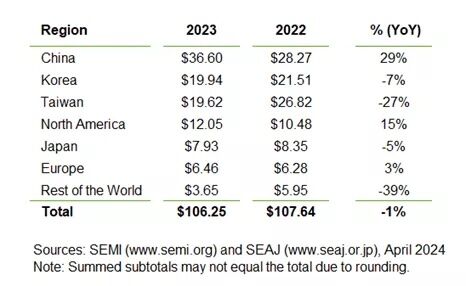Listening to Walter Roessger, president of Semi Europe, at a recent conference highlighting the upcoming Semicon Europe from April 12 to 14 in Munich/Germany, the IC equipment industry is in a precarious situation – between growth and correction. This is also especially true for Europe. “We have to be more innovative and creative”, the Semi Europe’s head admonished his compatriots, “and we need higher efficiency levels in our economies”.
That’s quite a somber story at the end of 2004/beginning of 2005, which saw gangbuster sales and growth – only to turn mixed and spotty now. But the concerns Roessger voiced are certainly feelable: right in the mid- and long-term outlook on technology challenges that the industry faces together with its main clientele, the semiconductor industry. “The end of optical lithography is near”, Roessger intoned. “R&D loads are getting ever higher, while the returns are getting smaller”. Consolidation – the watchword across all high-tech disciplines – is on everybody’s mind, especially in Europe although, of course, not only over here. Apparently, this will be one of the topics at the trade show in the Bavarian capital Munich and the following fab managers´ forum in Dresden/Germany on April 15.
To the big IC end
In the end, 2004 was a very good year for equipment makers. The total worldwide capital equipment market grew by something like more than 60%. But the increases didn’t fully land in Europe, whose market place’s share went down from 12% to 9%. Also, the Japanese market sank from 25 to 22%, the North American dramatically from 21 to 14%, and the Korean from 14 to 13%. The Taiwanese and China’s marketplaces clearly grow significantly, Taiwan from 13 to 20% consumption of global process equipment, China consuming now 8%. As we can see from this perspective, the European equipment market for semiconductor manufacture has experienced a downturn in terms of percentage-consumption, but still can be seen with a relatively stable volume in the range of about $2.3 to up to $2.6bn.
Another trend that Semi notes with some concern: the core cycles of the equipment business are getting deeper and bigger. The reason, according to Semi: there is an increasing time delay between fab construction and equipment installation. And in times of expensive fabtech advances, the role of the secondary market, of used equipment, is changing and growing in importance.
Sounding quite in tune with similar conclusions was Otto Kosgalwies, VP for infrastructure and services at STM, Europe’s “broadest” chip manufacturer. Worldwide IC sales in 2004 turned out to have grown by about 29%, Kosgalwies said, reaching $214bn. Over a period of five years, from 2003 to 2008, annual growth rates will average out at 12%, a bit lower than the traditional mark but still quite good. However, according to STM’s executives, 2005 will experience a market correction yielding a growth “in the single digits” only. And this may well be the optimistic view, since semiconductor-market researchers have released a broad spectrum of expectations until now: from a slight growth down a minus of more than 5%.
Volatile capex figure
Another major difference between 2004 and 2005: capital investment (capex) growth (pegged at 55%, to $47bn in 2004) this year will slow down substantially. There too, a correction is upon us, as confirmed by Semi’s year-end consensus forecast for 2005. Sales of semiconductor equipment, the Semi consensus projects, will show a “moderate cyclic decline” to $35.3bn, which is a contraction of about 5%. Relatively untouched will be wafer-processing equipment, the largest segment, with a 3% decline, to 23.2bn. However, test equipment, which grew in 2004 by more than 50%, in 2005 will decrease by a hefty 9%, down to $5.64bn. Assembly and packaging equipment will decline even further by 15%, only to expectedly rise again by 11% in 2006 and by 25% in 2007. But the semiconductor cycle being flat from 2004 to 2005 is expected to gain momentum in 2006 to reach about an estimated $228bn, and the SIA/WST semiconductor market pundits expect even $259 for 2007.
Whether or not the upcoming European semiconductor-industry event will now provide helpful answers to see absolutely clear for 2006 and 2007 can really be doubted. And even for this year at its beginning, a valid economical overview is hard to gain in this highly volatile market with all its unpredictable variables and influence from many sides. Latest research says that semiconductor inventory in the supply chain which has grown to about $1.6bn has again reached about $1bn (not the expected 1.5) in the last quarter of 2004. This gives hope that bookings will not sail down to the bottom to compensate for excess semiconductors. So, many in the industry are now speaking of a slight growth of up to 5% in total.
The lead-free issue
Another word to RoHS (reduction of hazardous substances) and its implementation in microelectronics which urges board assemblers to use lead-free components for their products to be sold from July 2006: we have learned so far that it’s easier to get solder pastes and PCBs in best lead-free qualities – but the still unknown variables are the components. And not to be forgotten: the plastic ingredients of these parts have to withstand the significantly higher process temperatures. As we can see today, not every issue in this respect seems to be solved from all supplier’s sides. This is a really not peanuts, since the European semiconductor market with its 19% share (the same as the Americas) amounts to about $41bn. Still, Japanese consumption with about $49bn is a chunk larger by far, the other areas of Asia, especially China, will be picking up more. So, in 3 to 4 years, the semiconductor market of the Land of Smile will be the biggest globally, as all relevant predictions say. All of Asia will then consume about 65% of the worldwide semiconductor production.
Werner Schulz/Gerhard B. Wolski
EPP EUROPE 400
Share:









